#Ronkeys animations
Explore tagged Tumblr posts
Text
hi! i wrote an essay about rosy ronkey and her clothes, and i hypothesized what time period i think shes from/inspired by ^^ below if you wanna read more :))
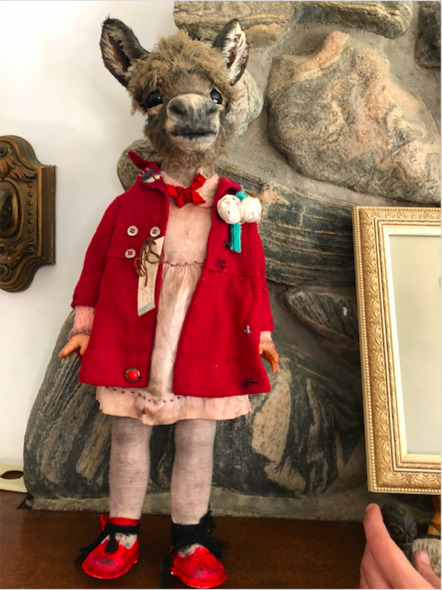
ive been fixated (or had a special interest or whatever you want to call it) on rosy ronkey for a YEAR today. i've always been pretty interested in her outfit from an aesthetically pleasing point of view, but recently i wanted to see if i could find any trends and time periods in the inspirations of her clothes, which is what this essay is about! it’s going to be an explanation of most of her clothes, top to bottom, from what i can assume with the research i've done. i say research, but i probably don’t have the best sources? they’ll be linked below, but it was really more cross-referencing than anything else lol
i reached out to annie montgomerie for comment/criticism, but she’s obviously very busy and i enjoyed my research from a subjective point of view :)
basic specs on rosy (no one else but me cares): looking at rosy, the only zoomorphic, or animal looking, aspect of hers is her head. judging by proportions and cross-referencing, she looks to have the body of an american girl doll. this is just what i’ve noticed, but annie’s most recent stuff is way less anthropomorphized compared to rosy and the group she was made with. looking at annie’s most recent exhibit, hand me downs, every single piece is completely animal, with hand-sculpted claws, paws, wings and hooves. some of these dolls legs still look like american girl doll legs, but most everything else is animalistic. this isn’t important, but i just thought id mention it because artists’ growth over time is cool!
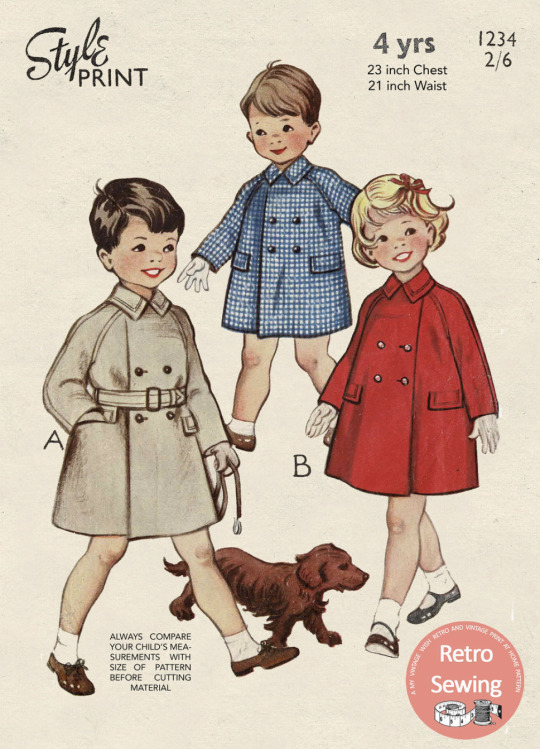
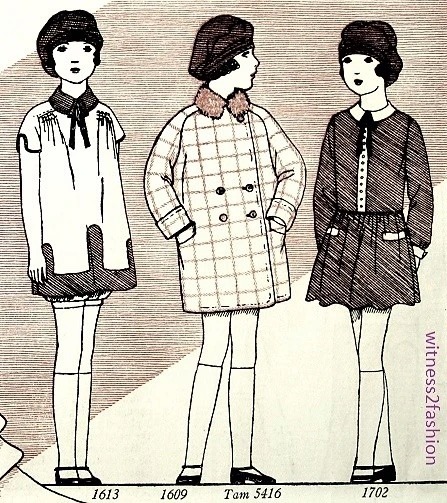
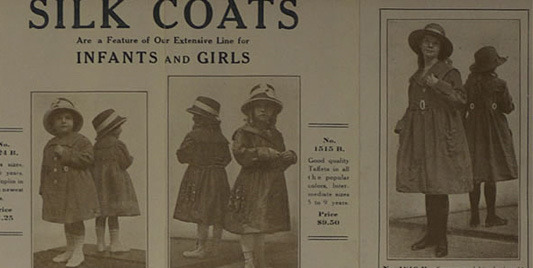
starting with her coat, it looks like a double-breasted red childrens’ coat with two rows of two buttons each. these kinds of coats are still available today, but i could find the closest matches by looking at 1920s childrens’ coats, specifically rothschild coats. the rothschild family has a long and complicated history, but all that’s important to know is that they are new york based (which doesn’t totally fit my assumptions about her; in general i assume all of annie montgomerie’s dolls are british because of her nationality) and they’ve been in business for over 100 years. by cross-referencing the growing style of double-breasted coats in the 1920s, and the style of rothschild childrens’ coats in ads from the time, i feel like it’s easy to assume rosy's character has this coat, or at least was very heavily inspired by it.
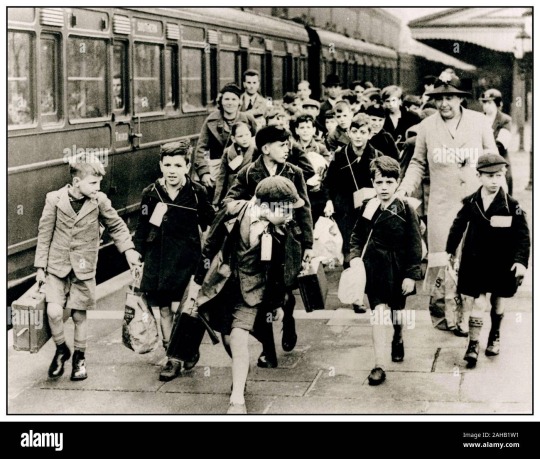
a theory i’ve seen before is that the ticket on her coat is a luggage label. these were used during WWII to evacuate british children during the blitz. the history press site says luggage labels listed “name, school and evacuation authority,” and is also where i got most of my information. i want to tentatively deny this theory. i'm pretty sure the ticket is an annie montgomerie staple opposed to a part of rosys' character. she's shown with the tag in the yorkshire sculpture park video, and on gerard way’s website, but she’s missing it in all the photos posted by annie montgomerie herself on facebook and instagram. almost every single annie montgomerie piece on display or for sale has a tag as well. i love this theory, and it’s probably what got me interested in researching her outfit in the first place, but i don’t think i could prove it if i tried.
other than the ticket, she has white roses on the left side of her coat and some smaller twigs? sticks? pinned to her collar. white roses symbolize purity, youthfulness, innocence, and in some contexts, respect for the departed. i couldn’t find any historical photos of children with roses in their outfits, but across the board that was the result i got for their meaning. i can’t discern what she has on her right collar for the life of me, if someone else can figure this out, PLEASE tell me

her dress is pink, with a cinched embroidered waist and a peter pan collar. peter pan collars became popular in the 1920s, and have been a staple of childrens’ dresses since (sources for this one were a few blogs and wikipedia, but also some ads, so i feel pretty confident with it.) some ads for girls’ dresses in the 1920s had the same soft pleats and embroidered waist as seen on rosys’ dress. i don’t think there’s a meaning behind the color, except that it compliments the red coat and her fur.
her stockings are standard, I couldn’t find much special meaning behind them, british children have been wearing stockings forever, and for girls especially, stockings became more popular in the 1920s as dresses got shorter. usually they were sheer and nude, and rosys’ look like the gray kind kids wear today, but i think it’s still period appropriate to an extent. her shoes look like red mary janes for american girl dolls, just more scuffed and dirtied. mary jane shoes themselves have been around for a while (called “bar shoes” originally,) but they got their name in 1904. in one of the first drafts for this, i read the fairy tale “the red shoes” to see if it offered any insight. i thought it’d be fun to relate, but it’s just a popular danish fairy tale, and it was hard for me to entertain the idea for long.
TLDR: i think rosy ronkeys outfit is inspired by british 1920s fashion!
that’s all I have! i apologize if this was underwhelming or overwhelming or whatever, i had no model to base this off of and the only tumblr essays i read are from my friends <3 i hope you enjoyed! i love rosy ronkey!
link to my dumbfuck google doc with all the links and braindump on it :)
211 notes
·
View notes
Note
Where did Rosy Ronkey even come from is it like a video or
she was made by an artist called annie montgomerie! she makes loads of adorable little animal/doll hybrids and a few years ago gerard bought her!
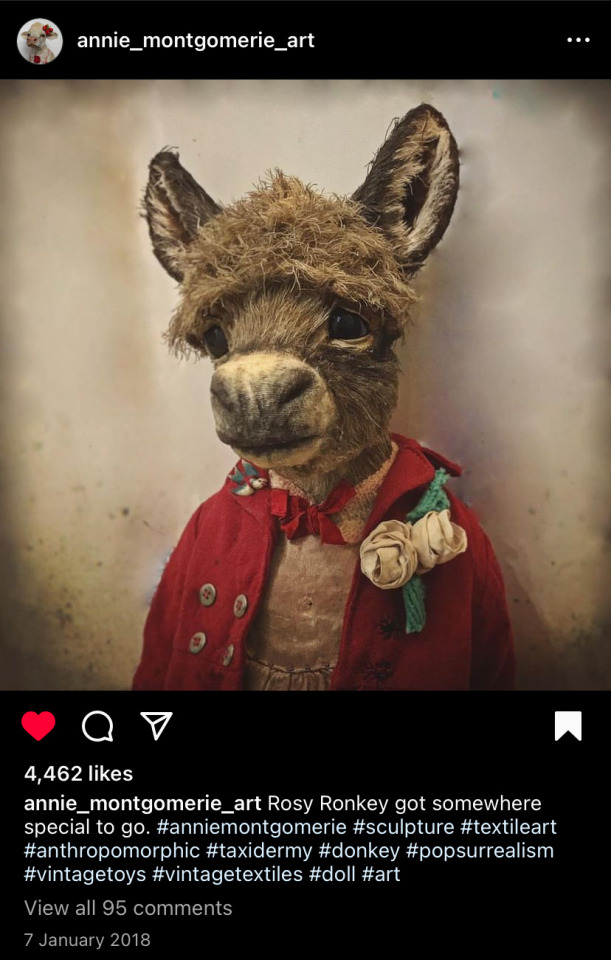
then when annies art was on display somewhere gerard did an introduction video for her work and talked about why they love rosy and it's painfully adorable
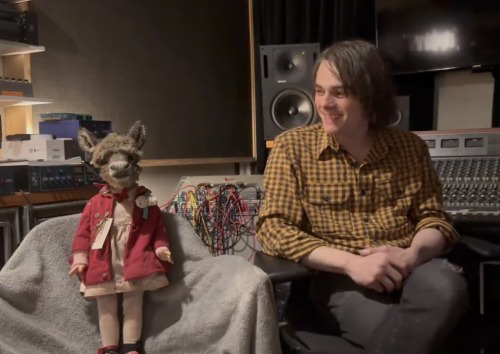
46 notes
·
View notes
Text
Animation sketch dump INCOMING
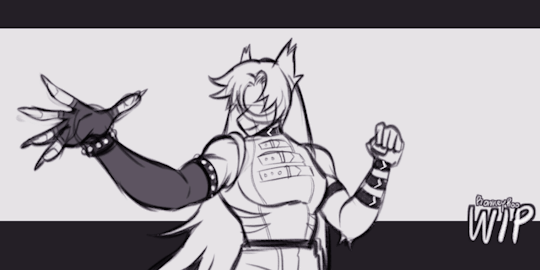
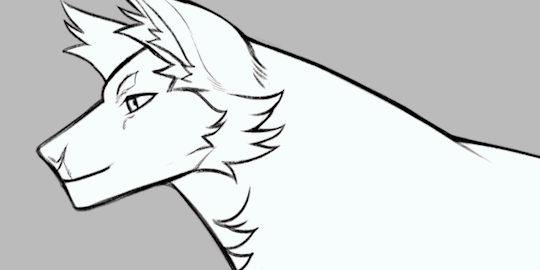
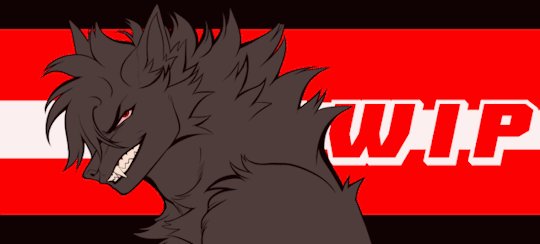
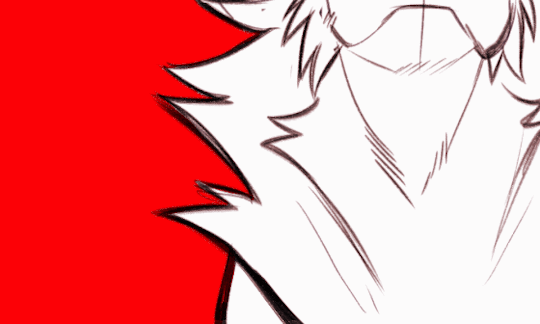

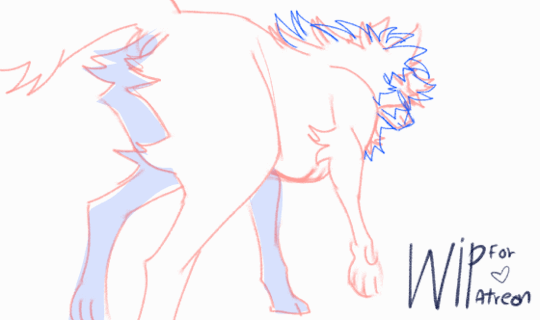
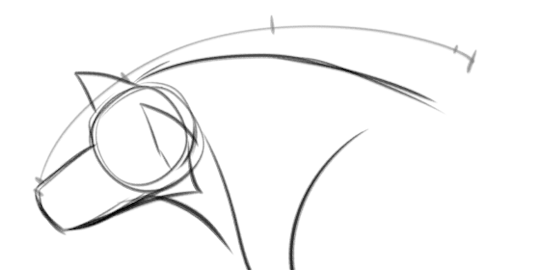

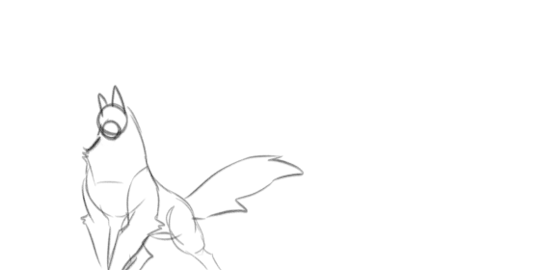

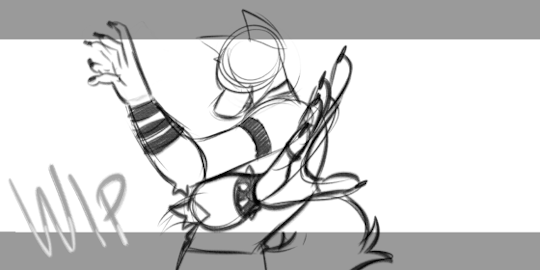

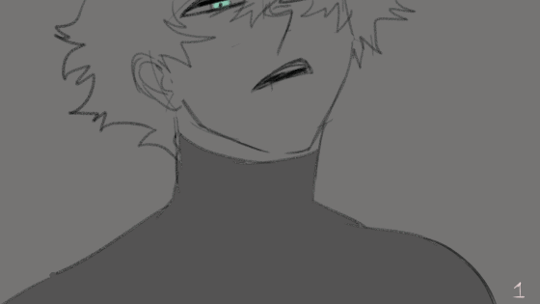
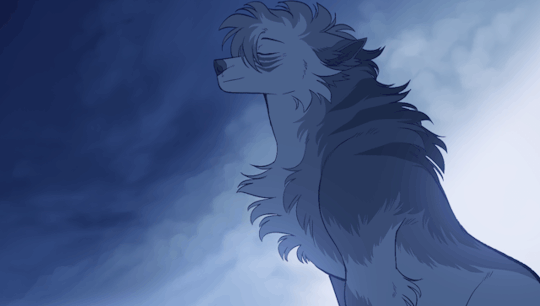
way too many wips and abandoned projects for animation videos god knows if ill ever finish 🥲
#WIPS#Ronkeys animations#OC art#Raven#Shayu#Negative!Shayu#And many others#thought itd be interesting to share!#i still feel so bittersweet about all of these#i wish i had all the time in the world to complete my favorite ones#tw; body horror#tw; gore
645 notes
·
View notes
Photo
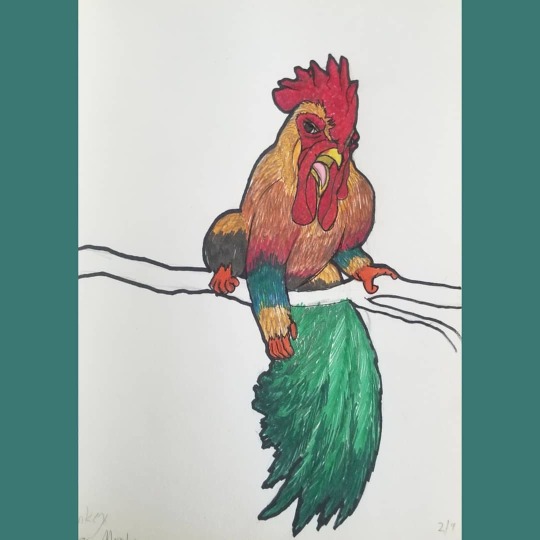
Day 291 Ronkey = Monkey + Rooster The splicing vats have spat out another horror. This one is loud. #draw #drawing #doodle #sketch #sketchbook #pen #paper #cartoon #marker #art #artdrawing #ohthecolors #colorful #drawingchallenge #dailydrawing #daily #animals #hybrid #mix #unnatural #creature #rooster #monkey #zodiac (at 深圳鹽田) https://www.instagram.com/p/CFBEgO2DBkp/?igshid=1bdjea8v6icyx
#draw#drawing#doodle#sketch#sketchbook#pen#paper#cartoon#marker#art#artdrawing#ohthecolors#colorful#drawingchallenge#dailydrawing#daily#animals#hybrid#mix#unnatural#creature#rooster#monkey#zodiac
0 notes
Text
(Part 5)
The middle Neomyocene Era at 400 million years PE is a period of great diversity, but also a epoch of numerous extinction as the dropping seas and cooling temperate climes create great disturbances to the status quo. Flightless ratbirds on formerly isolated ecosystems would be decimated by new competitors, lower sea levels would eventually kill off many of the reefs and algae forests in the shallows, and on land larger neomice would become more diverse than ever before. Some of the greater creatures of the Pelagocene would continue on in the middle Neomyocene, such as the reagles, retaining their status as aerial apex predator and spreading to multiple continents, and the noseydicks, largest of the snorcas, who continue to thrive in the deep open ocean even as the smaller dolphin-like forms decline with the loss of the shallow seas.
But one lineage of neomice would become the most sucessful in the mid-Neomyocene, thriving in the canopy of the temperate forests that come to dominate in the cooler climate. Known as the primesters, they would converge highly with the squimians and ronkeys of the Temperocene, being arboreal climbers with opposable digits that feed on fruit, seeds and invertebrates.
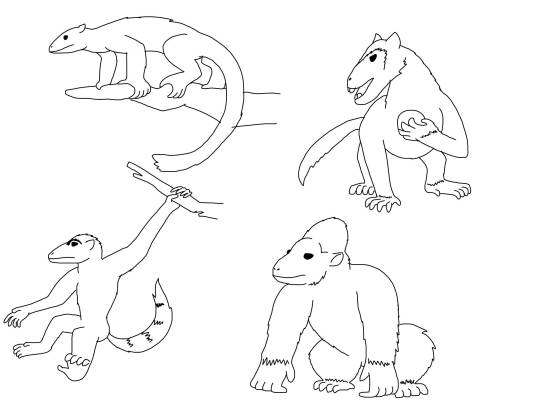
Increased predation from the arboreal ferrats known as nekorattas and gengiskats would force many primesters into social groups for protection, where, over time, they would develop increased cooperation and communal rearing of young, a set of behaviors that would bring about a progressive increase in intelligence in the species as time went on. Lemur-like yeeyees would become abundant in the canopies, with family groups working together to search for food and fend off enemies. These primitive primesters would give rise to a more advanced lineage, the hamkeys, including species such as the ground-dwelling hamdrill, a highly-intelligent omnivore that uses its dexterous, prehensile limbs for using tools like sticks and rocks, and the striped baccoons, whose flashy coloration and distinctive vocalizations form a type of complex communication which they used to relay information to other members of their troops to warn for danger or lead them to food. Eventually one group of hamkeys, the furrillas, distinctive by their lack of tails, knuckle-walking gaits and larger sizes, would reach a milestone of interest: they not only discovered how to use tools, but to actively make them, and soon they were using tools to make other tools, which allowed them to access food sources they previously could not before.

And then something bizarre, and uncannily familiar, would happen in the late Neomyocene, 420 million years PE. Some of the furrillas, facing plenty of competition in the trees due to the success of the primesters, would seek out their fortune in the open plains, where plenty of grasses grew that bore edible seeds. Some of these furrillas, pressured by the need to see higher up above the grass, become the bipedal hamsquatches, and with their forelimbs freed from locomotion the hamsquatches would develop more dexterous hands that could better craft tools and use weapons to defend themselves against the plains predators such as the dolgs and ursadogs. This eventually would cause them to further specialize into a fully erect walker, the ratmanbobbin, which would lose their opposable toes and develop longer legs and shorter arms to become more efficient bipedal walkers.
Eventually, the ratmanbobbins would discover a key achievement that would spur their evolution to a brand-new level: they gradually switched to a more-carnivorous diet, first scavenging off dead animals and eventually learning how to hunt big game, driving herds of rambis and distapirs into pitfall traps lined with wooden spikes. The inclusion of nutritious, protein-rich meat in their diet would allow the evolution of bigger brains, and eventually, one species would reach a spark of self-awareness, and converge heavily on the very beings that introduced their miniscule ancestors to the planet nearly half a billion years ago-- the sixth and final sophont of the Hamster's Paradise: the mousey micks.
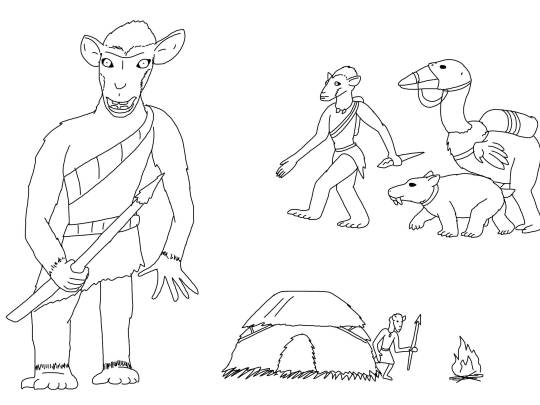
Converging with the anthropoid form to a downright uncomfortable and disturbing degree, the mousey micks suffered none of the pitfalls of the previous sapient species: they weren't as unnecessarily violent toward their own kind as the harmsters were, they weren't completely dependent on another species to maintain their civilization as the baywulves did, they weren't limited by their environment and anatomy to hinder their advancement unlike the roddolphs, and they weren't in a desperate competition against another intelligent species, like the gryphs and the sauronts. With their circumstances far more favorable than their forebearers, they would become the planet's most sucessful intelligent species, advancing to a sophisticated agricultural and industrial level as the millenia passed.
The mousey micks would begin as hunter-gatherers of the grassy plains, but soon would discover agriculture and start farming the grass-seeds that grew in abundance as an alternate source of food to supplement their hunts, selectively breeding them for bigger and tastier seeds which they would use in a wide variety of fermented and baked bread-like foodstuffs that would become part of their staple diets. They would also domesticate certain animals during this time: the ploofy, a small saber-toothed dolg related to the jeggo, as guards for their farms and as hunting companions, and the doneldonk, a large flightless ratbird that would serve as their mounts and beasts of burden.
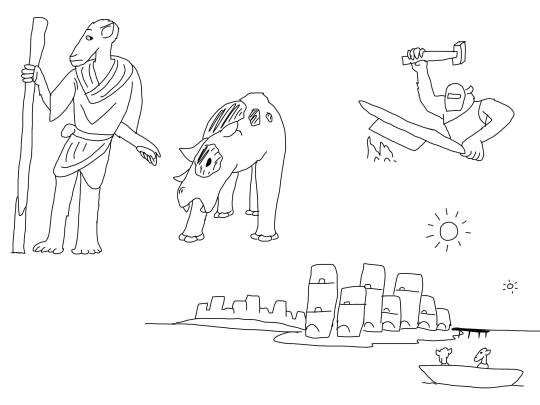
They would also domesticate a slow-moving, grazing relative of the rambi, for its milk, meat and hides, and selectively breed it into a docile herding livestock, known as the khao. Many of the mousey micks would become herders, riding through the plains on doneldonk-back while trained ploofys helped them herd their flocks and protect them from predators, especially slenderhounds, which were persistent attackers to the khao herds and were considered quite a pest.
Soon, about 5,000 years after the advent of civilization, the mousey micks would develop metalworking and become able to produce better tools and larger, stronger homes that could withstand weather and disaster far better than their old houses of mud and wood. This was the age when larger cities would be built, technology would advance, and the mousey micks would begin exploring the world on ships, contacting other cultures that developed on different continents--for better or for worse. This was the time when an industrial phase of their technology would commence, as thousands of mousey micks living in cities would see about their needs being met by the mass production of food, tools and materials. As living conditions improved, populations would boom into the billions: a development favorable for them, but not so much for the rest of the planet- especially for their close relatives the hamsquatches and ratmanbobbins, who would be crowded out into extinction by their more-advanced cousins.

Eventually the industrial societies would become highly advanced, but with tremendous negative impacts to the environment. The increase of their booming populations required plenty of food to sustain them, and thus they began factory-farming the khao on an enormous scale, with their digestive processes producing immense quantities of methane at an unprecedented rate: a process that would only be aggravated by the numerous factories, utilizing fossil fuels formed from swamp vegetation during the Mouseozoic era. These would dump large quantities of air pollutants into the atmosphere, one that would begin a nefarious chain reaction that would slowly alter the climate.
In the meantime, their burgeoning settlements would gradually displace the natural environments on the planet: as forests, plains and jungles gave way to sprawling urbanized areas the increased habitat loss would bring about mass extinctions of the Neomyocene megafauna-- careless as they were, the mousey micks were oblivious to the meaning of these extinctions and the effect their advancement was having on the environment. Some small creatures, however, would thrive in these urban jungles: aside from the domesticated ploofys and doneldonks, which by this time were of less practical use and were being bred into fancy varieties as pets and show animals, there were plenty of wild creatures that would flourish in the new landscape: small squirrel-like squrats that emerged from dark crevices and basements at night to feed off the abundance of garbage and refuse, gecko-like ratptiles called liddards that feasted on the buffet of insects drawn by artificial lighting, and ratbirds known as piggyons, which perched in great numbers on the city rooftops, wires and lampposts, and whose droppings were a major nuisance for the city folk: urban rodents becoming household pests in a city built by a different kind of urban rodent.

Eventually, 3,000 years after the industrial revolution, the fossil fuels would finally run out, causing major societal and economic crisis that would threaten the collapse of society. By this point the global population had exploded to 10 billion and the ecosystem was strained to its breaking point, with heavily-polluted cities spanning almost the entirety of the globe and a runaway greenhouse effect gradually affecting agriculture and heating up the climate.
Desperate for solutions, the mousey micks would search for alternative sources of power, eventually drilling deep into the ground, discovering and resorting to nuclear power as they mined for radioactive ores. This had the potential for a far more sustainable and usable energy source, but in a tragic twist, it would end up being misused by positions in power: a more nefarious use would be found for those with ill intent, while those with good intentions would make terrible mistakes along the way in their attempts to fix the crisis that would only make it worse.
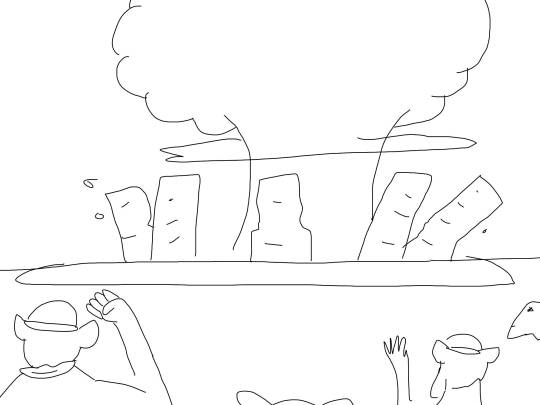
The misuse of nuclear power, the masses of desperate populations, the greed of those in powerful leadership roles and the degeneration of the planet's habitability would eventually cause numerous factions of the mousey micks to engage in conflict, eventually erupting into a world war that would lead to mass destruction and casualties by the billions. Meanwhile, well-intentioned scientific communities, seeking to halt the climate crisis, would create specialized technology that would not work as planned: these benevolent attempts would end up destabilizing the planet's magnetic field, causing weather patterns to go awry, and gradually making the climate crisis even worse for life as a whole.
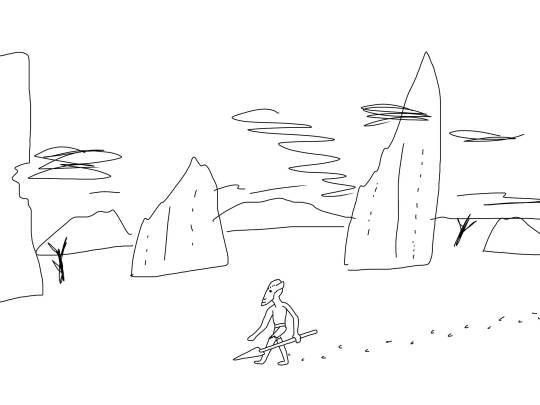
In the end, 20,000 years after the dawn of mousey mick civilization, their society would collapse into ruin in a world forever broken by the final sophont whose irresponsible use of their homeworld and their tinkering with the natural order would finally seal the fate of all life on this planet. As the world became ever more inhospitable, the last of the mousey micks that survive in the post-apocalyptic landscape revert to tribalism and anarchic chaos, with later, uneducated generations entirely losing all knowledge of the great civilization that once was. Soon even these would dwindle away as natural selection once again took hold, and the final individual, an adolescent orphan with no living family, no name and no knowledge of the world before or now, would be unceremoniously trampled to death in a failed attempt to hunt a herd of feral khao and finally bring the last of the planet's greatest species to its ultimate end.
The world at this point, 430 million years PE, was dying, slowly doomed by the actions of an arrogant and ultimately short-lived species, who despite their tremendous success compared to the intelligent species before them was but a miniscule blip in the radar of the cosmos, never advancing into the space beyond and leaving behind a slowly-deteriorating planet in their wake, one that was slowly- and irreversibly- becoming an arid wasteland as the greenhouse effect and the magnetic disruptions took hold.
The end of the mousey micks' civilization would also herald the end of the Neomyocene Era, with a mass extinction that would claim more than just the mousey micks themselves. But even as the planet approached its twilight days, life was not quite over, as the increasingly inhospitable conditions would prove as one ultimate challenge for the hardiest and most adaptable of the planet's life, heralding the final endgame of the planet's organisms and the last epoch of the planet's habitable age: the Terminocene Era.
(Part 6 finale to be continued...)
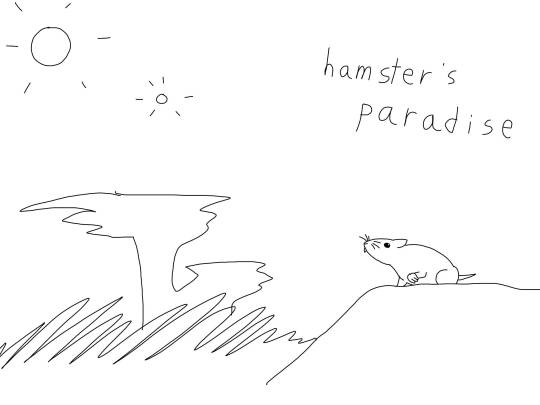
So I've been clearing out my old files and stumbled upon this old scrapped concept I had all the way back since 2017, a seed world project inspired when I first started reading Serina. It was just some random stuff I ended up doing just for fun but I was surprised at all the notes and sketches I'd made of it a long time back, and looking back four years later there may have been quite some really unrealistic evolutionary paths and a rather...pessimistic and kinda misanthropic outlook on sapient species repeatedly evolving and inevitably destroying themselves and the world around them.
But hey, thought it had some interesting ideas so without further ado: "Hamster's Paradise".
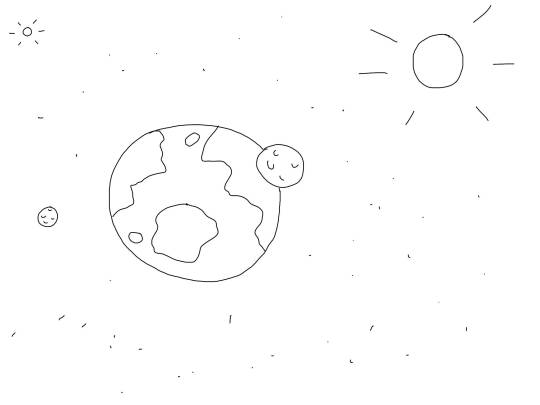
The timeline all begins on a suitable, habitable Earth-like planet, orbited by two moons and in a binary system with a yellow sun-like main star and a small orange dwarf that orbited further out and sometimes left nighttime as illuminated as nautical twilight. It was seeded with Earth organisms in preparation to human colonization and all the necessary organisms to maintain a sustainable, habitable biome, with various plants, fungi, decomposers, insect pollinators, marine algae, plankton and the like. However, there were no vertebrate life on the planet save for one test organism introduced to monitor the habitability of the biomes: the Chinese dwarf hamster, Cricetulus griseus.
But for one reason or another, humans never returned to the planet: whether they became extinct, abandoned the project, or managed to colonize another planet, it didn't matter: all that did was that this world was never visited or interfered upon again by human hands. And so, the planet was left to its unlikely colonists: they flourished for the first few million years, experiencing massive boom-and-busts in their population as they repeatedly bred out of control, starved en masse when food dwindled, and the few survivors left to repopulate in the next cycle. Eventually after about 10,000 years the hamsters and the ecosystem began to hit a sustainable equilibrium, and as niches gradually became established, the processes of evolution began to do its work.
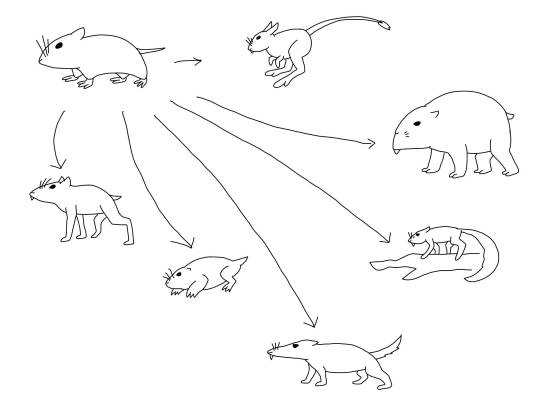
The first major epoch of the planet's history would be the Rodentocene Era, where the hamsters, still small but diverse, would begin to diverge into numerous different forms as they came to adopt new lifestyles and occupy new niches. Among these would be running mara-like herbivores, gopher-like burrowers and shrew-like insectivores, while one lineage, evolving longer tails and limbs, would give rise to squirrel-like climbers and jerboa-like hoppers. The biggest creatures at this time would be cavybaras, capybara-sized plains grazers, but throughout the Rodentocene Era, lasting from 1-20 million years post-establishment, none of the rodents would grow particularly large, remaining in small-mammal niches that modern rodents, shrews and lagomorphs would occupy on Earth.
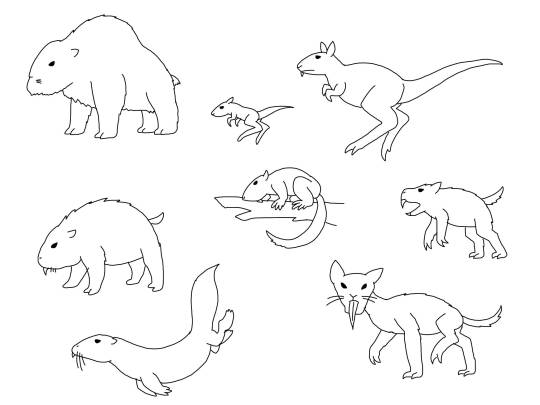
However a world occupied solely by small critters was not to last long, as 20 million years PE the first megafauna began to evolve, occupying bigger and bigger niches. By the 50 million year mark the next epoch, the Therocene Era, was in full swing: large rodents occupying big-mammal niches are widespread throughout all the continents at this point. The cavybaras soon give rise to the buffalo-sized mison and the omnivorous pig-sized bumbaa, the arboreal squirrel-like forms grow into lemur-sized squimians, and aquatic otter and beaver-like species also emerge. The jerboa-like hoppers give rise to the dominant plains grazers of this period: bipedal hoppers resembling macropods, such as the kangaroo-like boingo and its smaller wallaby-sized relative the oingo. Larger predatory forms have also evolved by this point, preying upon their distant relatives: the canid-like hamyena specializing on smaller prey, and the saber-toothed daggarat, which targets larger game such as the mison.
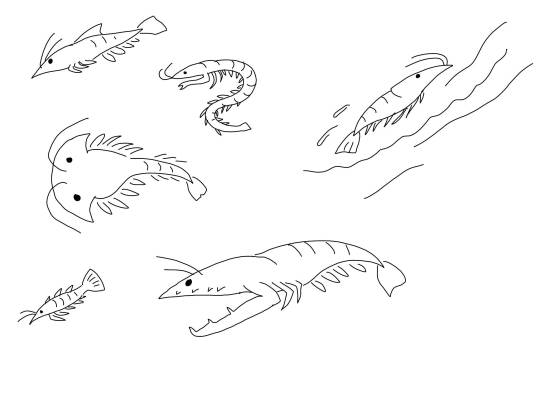
Meanwhile, a different sort of life flourishes in the oceans: in the absence of fish, small swimming krill-like crustaceans evolved into larger aquatic forms, eventually becoming the dominant aquatic lifeforms on the planet: the shrish. The shrish evolve into a diverse array of aquatic species, such as the schooling open-water shrardines, the centipede-like shreel that hunts in coral reefs like a moray, the venomous trilobite-like shringray, the predatory shrark, and a migrating freshwater species, the shralmon, which swims upstream to spawn.
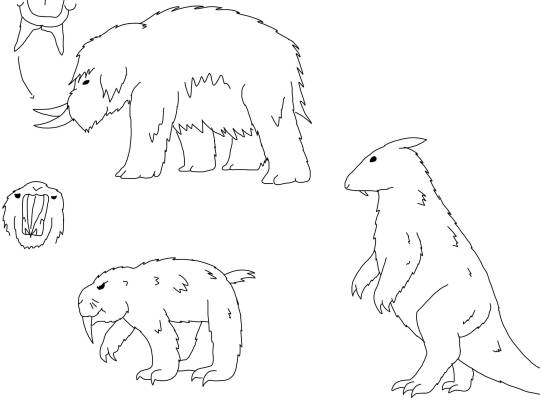
The Therocene Era ends with an ice age that creates large areas of permafrost and tundra, bringing about the Glaciocene Era: 80 million years PE. New forms adapted to the cold develop in the northern continent: a relative of the mison, the rakatusk, grows to elephantine proportions and sprouts a shaggy coat to insulate against the freezing cold, with tusk-like extensions of its incisors serving to dig for food and defend itself from its main predator: the snabre, a lion-sized descendant of the daggarat that fused its upper incisors into a single stabbing blade. Another beast of the ice ages is the lumbering drundle, a nine-foot relative of the boingos and oingos that, having become too heavy to hop, became a plodding bipedal browser, adapting its spine and hips to support such a means of locomotion.
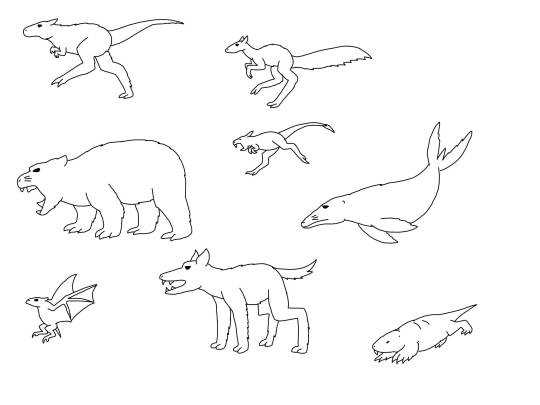
The climate would soon become milder 10 million years later and the icy tundras would shrink, but these cold-clime giants would persist throughout the Glaciocene, and some would later move down to the temperate regions and evolve into new forms. Most notably were descendants of the drundle that would become smaller and nimbler but retain their ancestor's bipedal walking: balanced by horizontal tails and with shorter forelimbs for grasping food, they became the hamstheropods, producing running plains grazers, alpaca-like mountain climbers, and one group of carnivorous predators, the ratptors. The ratptors, however, would be relegated to scavenger and mesopredator status, as the top carnivore niches were filled by the descendants of the hamyena: the carnohams, which sported Thylacoleo-like dentition, with conical stabbing incisors and meat-shearing first molars, and subdivided into two clades, the pack-hunting dog-like gringoes and the stocky, short-legged, strong-jawed bajas.
Other, smaller clades would become widespread in this era. Small, flying ratbats are abundant in the skies, feeding on insects and fruit, the aquatic otter-like species move out to sea and become shrish-eating seal-like phockas, and some of the burrowing gopher-like species become fully subterranean diggers known as horlocks, adapting to the low-oxygen environments underground by having slow metabolisms that lead to them becoming effectively cold-blooded, losing their pelage and converging with naked mole rats.
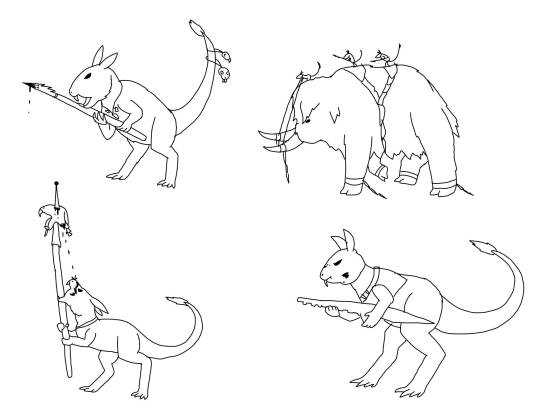
And then, at the end of the Glaciocene, 95 million years after life was first seeded onto the planet, an intelligent species evolves- a species that may very well represent the worst of the worst that sapience had to offer: the harmsters. Descended from pack-hunting ratptors, they were adaptable fast learners and eventually learned how to fell their prey with tools and weapons. The harshly-competitive environment selected for the smartest, most cunning and fiercest of the lot, and soon the harmsters attained self-awareness and soon began to construct a civilization: a civilization centered on war and violence.
As predators selected for both intelligence and ferocity, the harmsters were mentally geared to be incredibly vicious and cruel, displaying a penchant for genocide, bloodsport and even cannibalism, being promiscous breeders that eagerly feasted upon the weakest of their surplus young in bloody rituals. Though they were able to cooperate with each other to some degree, which aided in their construction of a civilization, their culture revolved around a sense of social darwinism, where the strongest were to rule and the weak were killed and devoured. Their violent ways spurred the rise and fall of numerous kingdoms during their brief reign: they engaged in massive wars between kingdoms with casualties numbering in the millions, breeding at rates expected of rodents and thus churning out legions of expendable troops that aided them in invading each other's territories and plundering their enemies' resources. Some of the kingdoms of the northern continent began enslaving rakatusks and comandeering them as weapons of war, living siege engines that trampled the opponents palaces with ease. This strategy would eventually lead to the rakatusk's extinction, as their already-dwindling populations were dragged into battle where they were felled without mercy.
Such a violent, merciless and brutal species was surely not long to last in this world, as they plundered and slaughtered their way across the northern continent driving many species to extinction in their wake, as the harmsters hunted them for food and sport with as much reckless abandon as they did butchering their own kind. Eventually the harmsters would briefly reach an industrial level of technology-- and unsurprisingly, use their newfound technology to create weapons of mass destruction that they turn against their own species. Too bloodthirsty and barbaric for their own long-term good, the harmsters would eventually bring about their own eradication, a mere 13,000 years ever since the first of them discovered the use of tools and began their bloody empires.
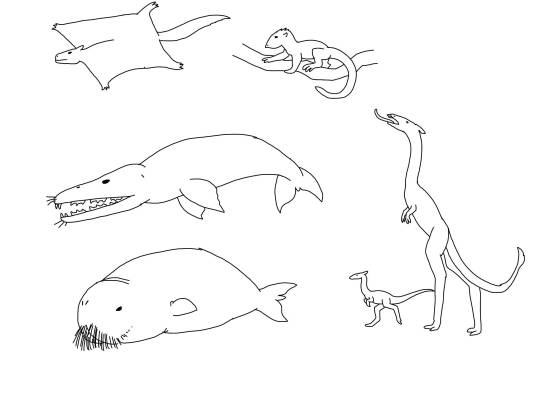
The brief rise and fall of an intelligent species ultimately was inconsequential to the grander scheme of life, and it was not long before geological processes swept away all traces of the harmsters' civilization, to be forgotten in the sands of time. In their absence, life simply began anew, in the Temperocene Era: 100 million years PE, a time of mild climates and new diversity that rebounded in the wake of the extinctions brought by the harmsters. The arboreal squimians diversified into monkey-like frugivores and gliding insectivores, while in the seas the phockas, nearly hunted to extinction by the harmsters, rebounded and became fully-aquatic hwhels, some which evolved multi-crowned teeth for catching small swimming prey, and others developing sieving bristles from modified whiskers to filter out zooplankton and krill from the water. On land, the hamstheropods reclaim the lands once ravaged by the wars of the harmsters, their own kin, and become ornithomimosaur-like runners of the savannah, with one group, the nenks, becoming twelve-foot long-necked browsers.
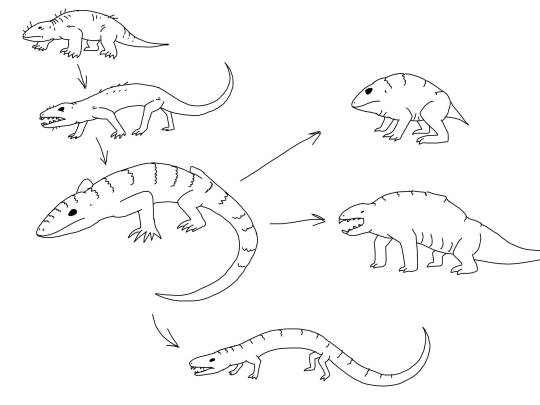
It was also during this warm and humid clime that one of the strangest lineages of the planet would arise. Descended from the burrowing horlocks, some of these unusual new species returned to the surface to exploit vacant niches, regaining their keen eyesight as they came to live above ground once again. The bristly remnants of their fur coats, no longer needed for insulation, would later evolve into overlapping pangolin-like scales to help protect their exposed hairless skins, and their decreased metabolisms, coupled with a long, fat-storing tail, helped them thrive as ambush hunters of insects in warm climates that needed far less food to survive than a typical rodent, using up less energy. With tough scaly skins, a nearly-cold-blooded metabolism, and sprawling limbs as a remnant of their burrowing ancestry, they became the ratptiles: a diverse clade of superficially lizard-like rodents that eventually diverge into long-bodied, flexible short-legged carnivores known as snerpents, herbivorous slow-moving species called biguanas, and even a clade of hopping stocky-bodied insectivorous toadents, which converged heavily on Earthly frogs save for their independence from water when breeding. Like all mammals, ratptiles gave birth to live young: however, they birthed up to thirty tiny but well-developed infants per litter, which were immediately independent from birth and needed no further parental care, simply being born in numbers great enough to ensure at least some would survive by sheer chance.
(Part 2 to be continued...)
#speculative evolution#speculative biology#spec evo#speculative zoology#science fiction#worldbuilding#rodents#hamsters#evolution#hamster's paradise
246 notes
·
View notes
Note
ONE SEVEN TWENTY EIGHT
1. Museum or aquarium date and why: we went to the museum together tjat was fun :)))) i think if i was autistic about sea creatures i would pick the aquarium. unforently im not so pick museum
7. If you could create ANY mix-up or mythical animal and have it be brought to life, what would it be? THIS IS A SUPER GOOD ONE UHHHHH i would really want rosy ronkey to be real. kidding. kind of. most sea creatures r like mythical to me tbh like they scare me. NO FURBIES FURBIES ARE REAL NOW
28. What/which music are you currently listening to? hello i Love you for this one !! i recently got a cd player so ive only really been listening to cds when im home and the only two ones i like are the clash combat rock album and now by paramore so that album and single :))) I LUV U THANKS FOR ASKING
2 notes
·
View notes